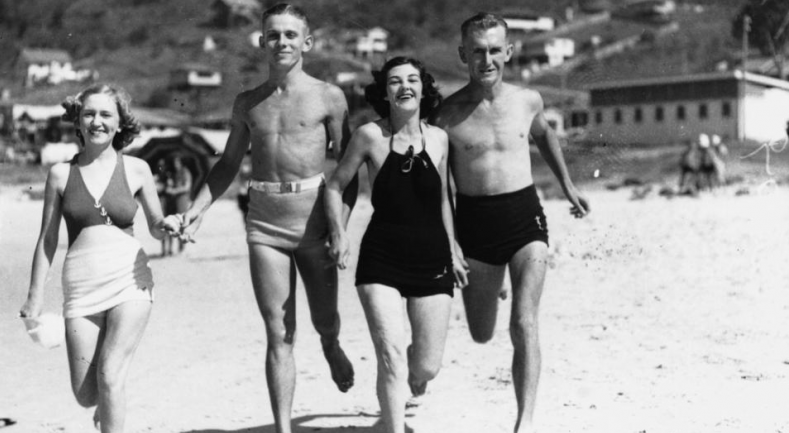Vintage Swimsuits are a sight to behold. By the 1930s on the Gold Coast, the tanning fad had started, and smaller swimsuits were all the rage. Silver takes a look at local beach fashions caught on early cameras.
Tan Fads
Up until the first part of the 20th century, many women of European origin thought pale skin was beautiful. But after thousands of years of wanting a “peaches and cream” complex, the tide turned. The 1920s had arrived, and now, pale people wanted to be tanned. Articles started to appear in magazines about the beauty of sun-kissed skin.

A group of young people enjoying a day at the beach, Gold Coast, dated 1930
A story in the Delineator Magazine in 1929 had the title “Tan Takes its Turn as a Maker of Fashion.” This new fashion may have been the result of actual health findings. The recent discovery of Vitamin D’s role in preventing rickets was big news at the time. Of course, there was another factor: a tan was a sign of status.

Bathers on the beach at Burleigh, Queensland: Miss Lil Delahunty and George Beasley, 21 December 1938
Swimsuits and Holiday Skin
In the 1930s many pale-skinned people still worked outside in the sun. Tanned skin was the mark of a labourer, the peasant. The aristocrats worked indoors, in banking and clerical jobs. But change was coming: In the 1920s and 1930s, the winter beach holiday started to become a thing, and only the wealthy could afford them. Sporting a winter tan – or any tan – became the rage in Europe, America, and Australia amongst pale-skinned people. And swimsuits started changing to catch the sunlight.

Knitted vintage swimsuits could look rather sexy! Grace Riordan makes an attractive beach study, 1938
Whoops
The tanning fashion persisted until Australians started getting skin cancer in droves. Now Australia has the highest incidence of melanoma and other skin cancers in the world. And it’s not just lighter-skinned people that are at risk – skin cancer rates for darker skinned people are creeping up too. Even in Aboriginal and Torres Strait Islander people, melanoma and other skin cancers cause deaths every year. Now, the rashie is de rigueur, especially for children. But back in the 1930s, sunbathers were oblivious to the danger, and they wanted to catch that tan.

Men’s vintage swimsuits looked a little weird! Beachgoers at Burleigh Heads, 1938: Mr and Mrs Roy Lores, Hylda Lores and Ron Barnett
Women’s Swimsuits in the 1930s
Women’s bathing suits in the 1920s often sported little skirts to hide the thighs, or were an ugly one-piece with long shorts. But by the 1930s, these hideous styles started to disappear. Lowcut bathing suits started to be more common, showing a lot of the back and chest. Legs became higher-cut, showing off the thigh. But this wasn’t for everyone, and many women stuck to more conservative styles.
Swimsuit Materials
As for the materials of choice in the 1930s, wool was often the fibre chosen for swimwear. Cotton was also a popular fabric. However, it didn’t have wool’s water-repelling properties. And, cotton would sag once wet.
There were also silk swimsuits. Australian Olympian Clare Dennis won the Women’s 200 Metre Breaststroke in at the 1932 Los Angeles Olympic Games in a silk swimsuit, rather than wool. It was an excellent fabric for swimsuits. But alas. Silk was too expensive for the average weekend swimmer. At this time, Speedo had emerged as a knitting mill. The company developed a wool swimming costume called the “racerback” and from then on, Speedo was seen as THE high-tech swimsuit maker. But not everyone could afford Speedo swimsuits. In the 1930s, many families solved this problem by simply knitting their own swimwear.

Young women enjoying a day at the beach at Southport, 1940
The Knitting Effect
The 1930s actually saw a revival in hand knitting, so the timing was perfect. Young women were making their own swimwear, copying styles they saw in magazines. They used wool with bright colours: It was cheap and accessible. And yet, not perfect: If the knitter got the swimsuit wrong, then it would sag in all the wrong places and they may get kicked off the beach for indecency! New materials were needed.

Marie McKenna and Gladys Cooling at Southport, 1938
Artificial Fibres
Innovative fabrics were coming onto the market but they could be a bit hit-and-miss. Rayon was an early solution. It dried faster than wool but didn’t always hold its shape. A company called American Rubber developed Lastex, an extruded rubber surrounded by fibre. This was a bit of a disaster. The material didn’t hold the colour, which just ran away after a couple of uses. Plus, the material didn’t hold its shape once wet – it was a floppy mess.

Young women modelling for an advertisement at Surfers paradise, for the department store T.C. Beirne
In 1939, duPont developed a nylon called 6.6 polymer that revolutionised swimwear. Swimsuits made from it were durable and dried quickly. The uptake was fast and cossies began hugging the body.
Other materials surfaced: Dacron, Orlon, Lycra, and Spandex found their way into swimsuit material. All this was revolutionary and made swimming a greater pleasure.

Amy and Maude Werth at the Queensland coast, thought to be around 1920
Men’s Swimsuits in the 1930s
By the 1930s men’s swimwear started to get smaller, but they still had a one-piece look to them that covered parts of the chest and back. The one-piece wool swimsuit remained a thing. But it was evolving. Armholes became larger, necklines bigger and lower, the backs became more open. Finally, though, towards the end of the 1930s, the men started to ditch the chest-coverings. By the end of the 1940s, all men were bare-chested. Competitive swimmers, wrestlers and boxers could all be topless to compete. You can’t hide a well-built body for long. The strong, superman body ideal of this era was now something to flaunt shamelessly at the beach. Swim trunks evolved into high-waisted shorts, with a belt. Eventually, the belt disappeared and they just started to look like huge undies with a drawstring.

Men’s vintage swimsuits! Early form of sand yachting on Coolangatta Beach, 1925. Three young men are seated on the windsurfer which consists of a large sail attached to a wheeled base
Fibres
Like women’s togs, most of the men’s togs of the 1930s were made from wool. They were roomy at the front, but tight around the legholes in case sagging provided too much information. Men’s togs in particular befitted from the revolution in synthetic fibres. Materials like spandex dried much faster than wool and cotton, and eventually replaced traditional materials altogether.
Now, men can choose budgie smugglers or boardshorts or both. And we can all thank synthetic fibres for that. Well, the budgie smugglers still have a lot to answer for.

Editor for Silver Magazine Gold Coast

